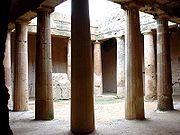
Tombs of the Kings (Paphos)
Encyclopedia

Necropolis
A necropolis is a large cemetery or burial ground, usually including structural tombs. The word comes from the Greek νεκρόπολις - nekropolis, literally meaning "city of the dead"...
lying about two kilometres north-west of Paphos
Paphos
Paphos , sometimes referred to as Pafos, is a coastal city in the southwest of Cyprus and the capital of Paphos District. In antiquity, two locations were called Paphos: Old Paphos and New Paphos. The currently inhabited city is New Paphos. It lies on the Mediterranean coast, about west of the...
harbour in Cyprus
Cyprus
Cyprus , officially the Republic of Cyprus , is a Eurasian island country, member of the European Union, in the Eastern Mediterranean, east of Greece, south of Turkey, west of Syria and north of Egypt. It is the third largest island in the Mediterranean Sea.The earliest known human activity on the...
. It is a UNESCO World Heritage Site.
The underground tomb
Tomb
A tomb is a repository for the remains of the dead. It is generally any structurally enclosed interment space or burial chamber, of varying sizes...
s, many of which date back to the 4th century BCE, are carved out of solid rock, and are thought to have been the burial sites of Paphitic aristocrats and high officials up to the third century CE (the name comes from the magnificence of the tombs; no kings were in fact buried here). Some of the tombs feature Doric columns
Doric order
The Doric order was one of the three orders or organizational systems of ancient Greek or classical architecture; the other two canonical orders were the Ionic and the Corinthian.-History:...
and fresco
Fresco
Fresco is any of several related mural painting types, executed on plaster on walls or ceilings. The word fresco comes from the Greek word affresca which derives from the Latin word for "fresh". Frescoes first developed in the ancient world and continued to be popular through the Renaissance...
ed walls. Archaeological excavations are still being carried out at the site. The tombs are cut into the native rock, and at times imitated the houses of the living.
Although the tombs have been known and casually explored for centuries, they were first subjected to systematic excavation in the later 1970s and the 1980s under the direction of Dr Sophocles Hadjisavvas, now Director of Antiquities of the Republic of Cyprus.
Dr Hadjisavvas has turned over to research students of the University of Sydney
University of Sydney
The University of Sydney is a public university located in Sydney, New South Wales. The main campus spreads across the suburbs of Camperdown and Darlington on the southwestern outskirts of the Sydney CBD. Founded in 1850, it is the oldest university in Australia and Oceania...
the preparations of the finds for publication.
Part of the importance of the tombs lies in the Paphian habit of including Rhodian amphorae among the offerings in a burial. Through the manufacturing stamps placed on the handles of these amphorae, it is possible to give them a date and, through them, the other material from the same burial.
Thus, it is hoped to develop a more secure chronology for archaeological material in the Eastern Mediterranean
Mediterranean Sea
The Mediterranean Sea is a sea connected to the Atlantic Ocean surrounded by the Mediterranean region and almost completely enclosed by land: on the north by Anatolia and Europe, on the south by North Africa, and on the east by the Levant...
of the Hellenistic and early Roman periods
Roman Empire
The Roman Empire was the post-Republican period of the ancient Roman civilization, characterised by an autocratic form of government and large territorial holdings in Europe and around the Mediterranean....
.
External links
- The Tombs of the Kings — University of Sydney

